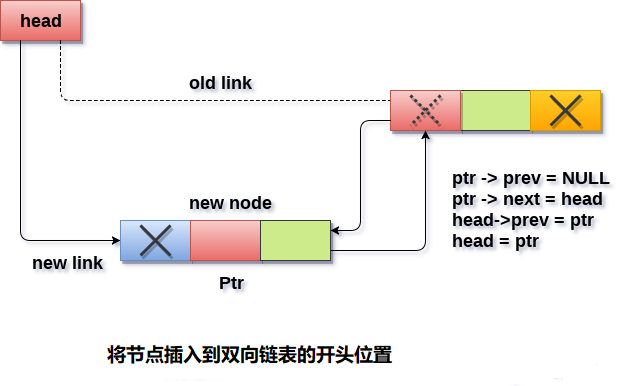在双向链表中每个节点都包含两个指针,因此与单链表相比,在双链表中保存有更多的指针。
将任何元素插入双向链表有两种情况。 链表为空或包含至少一个元素。 执行以下步骤以在双向链表的开头插入节点。
- 在内存中为新节点分配空间。这将通过使用以下语句来完成。
ptr = (struct node *)malloc(sizeof(struct node));
- 检查链表是否为空。 如果条件
head == NULL成立,则链表为空。 在这种情况下,节点将作为链表的唯一节点插入,因此节点的prev和next指针将指向NULL,并且头指针将指向此节点。ptr->next = NULL; ptr->prev=NULL; ptr->data=item; head=ptr; - 在第二种情况下,条件
head == NULL变为false,节点将在开头插入。 节点的下一个指针将指向节点的现有头指针。 现有head的prev指针将指向要插入的新节点。这将通过使用以下语句来完成。ptr->next = head; head->prev=ptr;
因为,插入的节点是链表的第一个节点,因此它的prev指针指向NULL。 因此,为其前一部分指定null并使头指向此节点。
ptr->prev = NULL;
head = ptr;
算法
第1步:IF ptr = NULL
提示 “OVERFLOW” 信息
转到第9步
[结束]
第2步:设置 NEW_NODE = ptr
第3步:SET ptr = ptr - > NEXT
第4步:设置 NEW_NODE - > DATA = VAL
第5步:设置 NEW_NODE - > PREV = NULL
第6步:设置 NEW_NODE - > NEXT = START
第7步:SET head - > PREV = NEW_NODE
第8步:SET head = NEW_NODE
第9步:退出
示意图

C语言实现示例 -
#include<stdio.h>
#include<stdlib.h>
void insertbeginning(int);
struct node
{
int data;
struct node *next;
struct node *prev;
};
struct node *head;
void main()
{
int choice, item;
do
{
printf("Enter the item which you want to insert?\n");
scanf("%d", &item);
insertbeginning(item);
printf("Press 0 to insert more ?\n");
scanf("%d", &choice);
} while (choice == 0);
}
void insertbeginning(int item)
{
struct node *ptr = (struct node *)malloc(sizeof(struct node));
if (ptr == NULL)
{
printf("OVERFLOW\n");
}
else
{
if (head == NULL)
{
ptr->next = NULL;
ptr->prev = NULL;
ptr->data = item;
head = ptr;
}
else
{
ptr->data = item;
ptr->prev = NULL;
ptr->next = head;
head->prev = ptr;
head = ptr;
}
}
}
执行上面示例代码,得到以下结果 -
Enter the item which you want to insert?
12
Press 0 to insert more ?
0
Enter the item which you want to insert?
23
Press 0 to insert more ?
2
